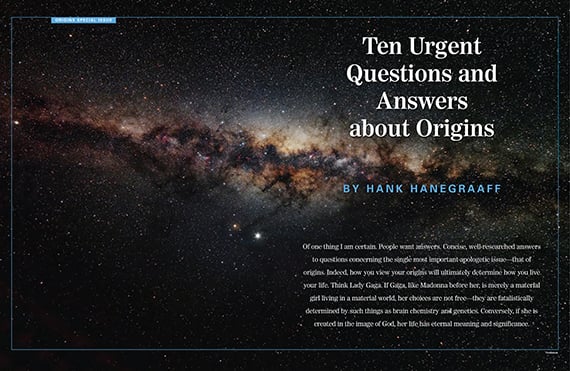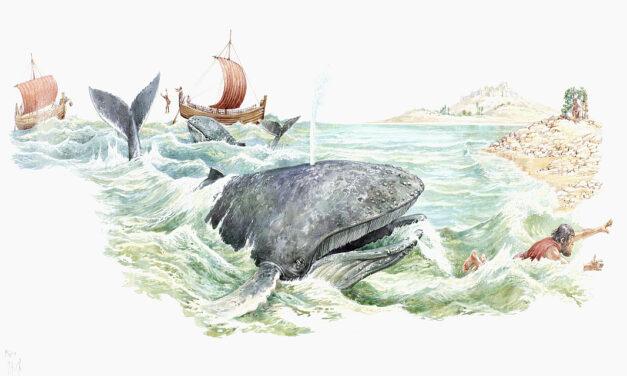This article first appeared in Christian Research Journal, volume 35, number 01 (2012). The full text of this article in PDF format can be obtained by clicking here. For more information about theChristian Research Journal, click here.
Of one thing I am certain. People want answers. Concise, well-researched answers to questions concerning the single most important apologetic issue—that of origins. Indeed, how you view your origins will ultimately determine how you live your life. Think Lady Gaga. If Gaga, like Madonna before her, is merely a material girl living in a material world, her choices are not free—they are fatalistically determined by such things as brain chemistry and genetics. Conversely, if she is created in the image of God, her life has eternal meaning and significance.
Here then are ten of the most urgent questions confronting Christians today concerning origins—along with ample evidence to believe that the opening words of Scripture, “In the beginning God created the heavens and the earth,” are perfectly suited for the age of scientific enlightenment in which we find ourselves.
DOES THE “FINE-TUNING OF THE UNIVERSE”
POINT TO A SOVEREIGN CREATOR?
One of the most astonishing discoveries of the twentieth century was that the universe is fine-tuned to support intelligent life. From the force of gravity to the balance of matter and anti-matter, the universe is balanced, as it were, on the fine edge of a razor.
Consider the force of gravity. If it were stronger (or weaker) by one part out of 10100 (that’s a 1 with a hundred zeros behind it!), the universe would not—could not—support intelligent life! Lest we miss the gravity of gravity’s fine-tuning, consider that the number of atoms in the entire known universe is only about 1080.
Furthermore, the fine-tuning of a force such as gravity could not be a function of physical law. Why? Because gravity could be stronger or weaker and still be gravity—so physical law does not dictate its precise value—but were it not fine-tuned as it is, it could not support intelligent life.
Finally, the fine-tuning of the universe cannot reasonably be attributed to chance because of the infinitesimally small range of values involved. Chance is infinitely more likely to produce a life-prohibiting universe than one that is life-sustaining.
The only plausible source of the fine-tuning of the universe is an external, transcendent, incalculably powerful and intelligent, personal Mind, who we call God.1
IS EARTH A PRIVILEGED PLANET DESIGNED
FOR SCIENTIFIC DISCOVERY?
Scientific sophists serendipitously suppose that Earth is a singularly insignificant speck of soil aimlessly adrift in a meaningless universe. As documented by astronomer Guillermo Gonzalez and philosopher Jay W. Richards, however, evidence refutes the principle of mediocrity (Copernican Principle), demonstrating instead that our Earth is a singularly privileged planet designed for discovery.
First, the unique conditions necessary to support intelligent life turn out to provide the best overall conditions for scientific discovery. Examples abound. Earth is situated between two spiral arms of a flattened spiral galaxy—the Milky Way—not too close to the core to be exposed to lethal radiation, comet collisions, or light pollution that would obscure observation of the distant universe; and not so far that a privileged planet could never form or where we would not observe different kinds of nearby stars. The atmosphere of our privileged planet is both oxygen-rich for survival and transparent for discovery. The moon is the perfect size and distance from Earth to stabilize rotation and to facilitate human habitability. Not only so, the moon and sun’s relative sizes and distances from Earth provide perfect solar eclipses, which played a vital role in the development of modern science (e.g., determination of the nature of stars and confirmation of Einstein’s General Theory of Relativity).
Furthermore, we live in the best overall age of the universe to do cosmology. In our time the cosmic background radiation left over from the Big Bang is readily observable, but it won’t always be—this radiation confirms that the universe is not eternal but began in the finite past. Moreover, most of the astrophysical phenomena astronomers rely on to measure the universe were not observable earlier in the universe’s development, and they will eventually fade (e.g., cosmic background radiation)—but neither could we have survived at earlier or later stages.
Finally, the setting of our privileged planet permits a stunning diversity of measurements, from the universe at large (cosmology) to the smallest of subatomic particles (quantum physics) to the middling size of Earth and humans (geology and anthropology).
From habitability to discoverability, Earth’s status in the universe is surely one of privilege. To reduce this to an accident of cosmic evolution is short-sighted; to recognize it as privileged, sublime.2
IS THE FINE-TUNING OF THE UNIVERSE
NEGATED BY THE NOTION OF A MULTIVERSE?
The theoretical physicist Stephen Hawking is infamous for supposing that the existence of a vast number of universes (multiverse) negates the fine-tuning of the universe. In other words, given a sufficient number of random universes, one of them is bound to have the necessary conditions to support not only intelligent life but the proposition that blind chance can account for fine-tuning. In reality, the multiverse proposition is an utterly desperate attempt to account for an unfathomably fine-tuned universe.
First, we should note that there is not a shred of empirical evidence to support the existence of a physical universe other than our own, much less a virtually infinite number of such universes. Hawking’s hope, and the hope of multitudes who share such fanatical presuppositions, is based on theological and theoretical pining, rather than scientific discovery.
Furthermore, in addition to undermining science, the multiverse hypothesis throws plain old common sense under the bus. Imagine trying to convict a murderer in a multiverse in which empirical evidence has been sacrificed on the altar of philosophically improbable propositions. In such a multiverse, stories of revolvers materializing out of thin air might well be as credible as eyewitness testimony.
Finally, eminent theoretical physicist—and Hawking colleague—Roger Penrose, though himself agnostic, has rightly concluded that the multiple universe hypothesis is both “impotent” and “misconceived.” The Big Bang turns out to be an event of almost infinitesimal probability, and the probabilistic resources provided by a multiverse turn out to be insufficiently rich. As such, the most plausible explanation for the fine-tuning of our universe is yet, “In the beginning, God created the heavens and the earth.”3
CAN THE BIG BANG BE
HARMONIZED WITH GENESIS?4
The Big Bang postulates that the universe began as an infinitely dense singularity and has since been expanding for billions of years. Though Big Bang cosmology is not communicated in the Genesis account of creation, it lends scientific credibility to the Scriptural contention that God created the universe ex nihilo (out of nothing).
First, like the Bible, the Big Bang postulates that the universe had a beginning. As such, it stands in stark opposition to the scientifically silly suggestion that the universe eternally existed.
Furthermore, if the universe had a beginning, it had to have a cause. Indeed, the cause of all space, time, matter, and energy must be nonspatial, nontemporal, immaterial, and unfathomably powerful and personal. As such, the Big Bang flies in the face of the philosophically preposterous proposition that the universe sprang into existence out of nothing and lends credence to the Genesis contention of an uncaused First Cause who spoke and the universe leapt into existence.
Finally, though evolutionists hold to Big Bang cosmology, the Big Bang does not presuppose biological evolution. In other words, Big Bang cosmology answers questions concerning the origin of the space-time continuum, as opposed to questions concerning the origin of biological life on earth.
While we must not stake our faith on Big Bang cosmology, we can be absolutely confident that as human understanding progresses creation will continue to point to the One who spoke and the universe leapt into existence.5
WERE THE GENESIS CREATION DAYS
LITERAL, LONG, OR LITERARY?
There are three dominant schools of thought within evangelical Christianity regarding the Genesis days of creation.
First, the popular twenty-four-hour view posits that God created the heavens and the Earth in six sequential literal days. A majority in this camp view the universe to be approximately six thousand years old and consider all death, including animal death, to be a direct function of Adam’s fall.
Furthermore, the day-age perspective posits that God created the heavens and the Earth in six long sequential day-ages totaling billions of years. In contrast to the twenty-four-hour perspective, the day-age view posits that nature red in tooth and claw is the result of God’s “very good” creation prior to Adam’s fall into a life of perpetual sin terminated by death.
Finally, the framework perspective holds that the seven days of creation are nonliteral, nonsequential but nonetheless historical. In concert with the day-age perspective, they view animal death to be consistent with the goodness of God’s creation and believe that the age question is settled by natural revelation (Book of Nature) rather than by special revelation (Bible).
In my view, the literary framework interpretation most closely corresponds to reality—though I cannot abide animal death prior to the fall as consistent with a “very good” creation (see discussion below under “Is Animal Suffering a Consequence of Adam’s Sin?”).6
WHEN WAS THE UNIVERSE CREATED?
Based on the speed of light (186,000 miles per second) astronomers have determined that the observable universe with its hundred billion galaxies each containing a hundred billion stars is at least fifteen billion light-years in diameter (a light-year is the distance light travels in a year—a distance measured not in billions, but trillions—about 5,878,499,810,000 miles!).
Furthermore, the age of the universe is measured in billions of years due to what is popularly referred to as the red-shift of the galaxies—the reddish light marking motion away from the Earth much like the audible pitch of a train shifting as it moves off into the distance. The red-shift marking galaxies moving apart at the speed of light allows astronomers to extrapolate backwards billions of years to a point at which the “stretching of space” began.
Finally, science points to realities such as background radiation, radioactive decay, entropy, star ages, and white dwarf stars as proof positive that the universe is billions of years old. For example, a star becomes a white dwarf (essentially a dead star) only after billions of years of nuclear fusion and subsequent cooling. These multiple independent empirical means all converge on a limited range of dates for the origin of the universe between ten and twenty billion years ago.
The finite nature of the universe—a universe measured only in billions of years not infinite time—is insufficient for the evolution of a protein molecule, much less a living cell.
DID GOD CREATE HIS HANDIWORK WITH
THE APPEARANCE OF AGE?
It is frequently argued that God created the universe and all it entails with the appearance of age. Does this correspond to the reality of both Scripture and science?
First, we should note that the Bible doesn’t answer the age question. Some say Adam was created with the appearance of age. In reality, we simply do not know. Was Adam created with calluses on his feet? Did he have a belly button? Was he fashioned replete with childhood memories? One would think not, but the Bible simply doesn’t say.
Furthermore, the notion that God created His handiwork with the appearance of age is logically unfalsifiable. In other words, you can neither prove it nor disprove it. For example, how could you falsify the notion that you were created five seconds ago and your recollection of the previous paragraph is just an implanted memory?
Finally, consider an observable astronomical event such as Supernova 1987a—with an identifiable “before” and “after.” Prior to 1987 this supernova was a star in a distant galaxy 168,000 light years away. On February 23rd, 1987, however, the star exploded, becoming a supernova. In other words, 168,000 years ago the star exploded and in 1987 the light of that event finally reached Earth—unless, of course, God created the universe 6,000 years ago. Then the supernova would be like a documentary film of an event that never really happened.
In sum, the notion that the universe is not authentically old but merely manifests the appearance of age creates more conundrums than it solves. Indeed, what good teacher would ask you to put your faith in a textbook intentionally filled with lies?
WHAT IS THE CAMBRIAN EXPLOSION?
The Cambrian Explosion is biology’s version of the Big Bang. Just as cosmology’s Big Bang undid the dogma of an eternal universe, biology’s Big Bang uprooted Darwin’s Tree of Life.
First, were all of geological history compressed into a twenty-four-hour clock, most of the distinct animal forms the world has ever known would appear suddenly within a two-minute time span at around the 21st hour. The abrupt and simultaneous appearance of this panoply of complex body plans signals an infusion of a vast amount of information, which can only rightly be attributed to an Intelligent Designer.
Furthermore, Darwin theorized that every organism evolved from a common ancestor as a result of natural selection acting on random variations. The Cambrian Explosion points in precisely the opposite direction. Darwin said it best, “The distinctiveness of specific forms, and their not being blended together by innumerable transitional links—is a very obvious difficulty.”
Finally, while Darwin predicted hundreds of thousands of transitional forms leading to the fossils of the Cambrian explosion, in actuality none appear. And since Darwin, the problem has only gotten worse. The fossil record has greatly expanded. Yet all known animal body plans appear in the form they possess today. In the words of Rudolf Raff, distinguished evolutionary biologist, “All of the known animal body plans seem to have appeared in the Cambrian Radiation.”
Darwin’s candor is to be commended. “If it could be demonstrated that any complex organ existed which could not possibly have been formed by numerous, successive, slight modifications, my theory would absolutely break down.” This is precisely what has happened.7
DID ADAM AND EVE REALLY EXIST?
A growing number of Christian thinkers say no. Francis Collins, founder of the Biologos Foundation and tapped by President Obama to be Director of the National Institutes of Health (NIH) is among them. In his view, science dictates that modern humans emerged from primates a hundred thousand years ago in a population numbering some ten thousand—not two. Not only so, but according to Biologos biblical expert Peter Enns, “the Bible itself invites a symbolic reading” respecting the first man and woman. Thus, the question: Did Adam and Eve exist, or are they merely allegorical?
First, while Collins and company staunchly defend Darwinian evolution, their views hardly correspond to reality. Darwin hung his hopes on hundreds of thousands of transitional forms leading to the fossils of the Cambrian explosion. In actuality the poverty of the fossil record has been an embarrassment. Virtually all known body plans appear abruptly in the Cambrian. Plainly put, the Cambrian radiation vaporized the Darwinian Tree of Life. Moreover, molecular biology has increasingly become an intractable enigma for Darwinian dogmatists.
Furthermore, Scripture plainly opposes the collective rhetoric of theistic evolutionists who deny the reality of a historical Adam and Eve. Paul made it crystal clear. “From one man God made every nation of men, that they should inhabit the whole earth” (Acts 17:26). Indeed, sacred Scripture in concert with sound science makes plain that kinds reproduce “according to their kinds.” Moreover, had the first Adam not fallen into a life of perpetual sin terminated by death, there would have been no need for a Second Adam. Paul was emphatic: “Since death came through a man, the resurrection of the dead comes also through a man. For as in Adam all die, so in Christ all will be made alive” (1 Cor. 15:21–22).
Finally, our Savior’s words should cast a pall on all Adam and Eve deniers. “At the beginning,” said Jesus, “the Creator made them male and female” (Matt. 19:4). Lest one be tempted to allegorize the words of our Lord, it is instructive to note that Jesus further affirmed a historical Adam and Eve when he referenced the murder of their son Abel (Matt. 23:35). Not only so, but Luke, writing to a primarily Gentile audience, extends his genealogy past Abraham to the first Adam, thus highlighting Christ, the Second Adam, as the Savior of all humanity. Should that prove insufficient, Chronicles provides a historical record from Adam to the exile. Likewise, Moses provides “the written account of Adam’s line” (Gen. 5:1).
Of one thing we can be absolutely certain, though Genesis is historical narrative interlaced with Jewish poetry, it is hardly a Collinsesque allegory.
IS ANIMAL SUFFERING A CONSEQUENCE
OF ADAM’S SIN?
“I cannot persuade myself,” wrote Darwin, “that a beneficent and omnipotent God would have designedly created the Ichneumonidae [parasitic wasps] with the express intention of their feeding within the living bodies of caterpillars.” This conundrum ultimately led Darwin to dispense with the notion of a Creator God. In reality, however, Adam, not the Almighty, bears culpability for the origin of moral and natural evil in the world.
First, the Bible contends that “sin entered the world through one man, and death through sin” (Rom. 5:12). And as a result, the whole of creation was subjected to “frustration” and “decay” (see Rom. 8:19–23; cf. Gen. 1:29–30; 9:1–4; Ps. 104:19–28).
Furthermore, the federal headship of Adam (Rom. 5:12–21; 1 Cor. 15:20–26) extends beyond humanity to all of God’s creation—even the ground was cursed as a direct result of Adam’s rebellion. Not only so, but the present curse and the promised redemption extends beyond the ground to the very animals that walk upon it (e.g., Isa. 11:6–9; 65:25; Rev. 21—22).
Finally, far from dispensing with God as a result of contemplating such natural horrors as a parasitic wasp, nature red in tooth and claw should have driven Darwin to contemplate the full consequences of alienation from God. Indeed, exposure to natural evil outside the comforts of the Garden must surely have caused Adam to understand the full gravity of his fall from grace. Put another way, chaos outside the Garden reflected the horror of his sin-sick soul.
Tragically, Darwin could only conceive of time as linear. Had he comprehended a God unbounded by time his evolutionary hypothesis may never have taken root. Surely God could cause effects of the fall to temporally precede their cause! As intelligent design theorist Dr. William Dembski has well said: “Just as the death and resurrection of Christ is responsible for the salvation of repentant people throughout all time, so the fall of humanity in the Garden of Eden is responsible for every natural evil throughout all time (future, present, past, and distant past preceding the fall).”8
Hank Hanegraaff is president of the Christian Research Institute and host of the Bible Answer Man broadcast heard daily throughout the United States and Canada via radio satellite radio Sirius-XM 131, and the Internet. For a list of stations airing the Bible Answer Man, or to listen online, log on to www.equip.org. Look for Hank’s forthcoming work, The Creation Answer Book (Thomas Nelson, 2012).
NOTES
- Source (and a resource for further study): William Lane Craig, Reasonable Faith: Christian Truth and Apologetics, 3rd ed. (Wheaton, IL: Crossway, 2008).
- Source (and a resource for further study): Guillermo Gonzalez and Jay W. Richards, The Privileged Planet: How Our Place in the Cosmos Is Designed for Discovery (Washington, DC: Regnery, 2004).
- Source (and resource for further study): Craig, Reasonable Faith.
- An earlier version of this question and answer appeared in Hank Hanegraaff, The Bible Answer Book, vol. 2 (Nashville: Thomas Nelson, 2006).
- Source (and resource for further study): Paul Copan and William Lane Craig, Creation Out of Nothing: A Biblical, Philosophical, and Scientific Exploration (Grand Rapids: Baker Academic, 2004).
- For further study, see The Genesis Debate: Three Views on the Days of Creation, ed. David G. Hagopian (Mission Viejo, CA: Crux Press, 2001).
- For further study, see Darwin’s Dilemma: The Mystery of the Cambrian Fossil Record (DVD) (Illustra Media, 2009).
- For further study, see William A. Dembski, The End of Christianity: Finding a Good God in an Evil World (Nashville: B and H, 2009).









